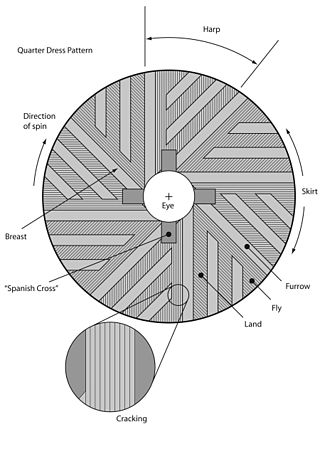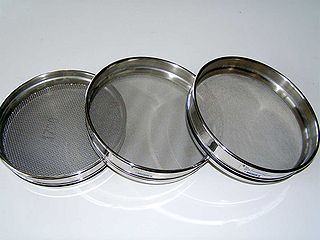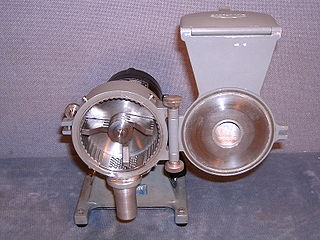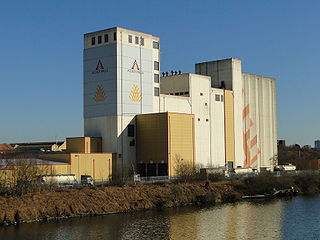
The oat, sometimes called the common oat, is a species of cereal grain grown for its seed, which is known by the same name. While oats are suitable for human consumption as oatmeal and rolled oats, one of the most common uses is as livestock feed. Oats are a nutrient-rich food associated with lower blood cholesterol when consumed regularly.

Flour is a powder made by grinding raw grains, roots, beans, nuts, or seeds. Flours are used to make many different foods. Cereal flour, particularly wheat flour, is the main ingredient of bread, which is a staple food for many cultures. Corn flour has been important in Mesoamerican cuisine since ancient times and remains a staple in the Americas. Rye flour is a constituent of bread in both Central Europe and Northern Europe.

Millstones or mill stones are stones used in gristmills, for grinding wheat or other grains. They are sometimes referred to as grindstones or grinding stones.

A sieve, fine mesh strainer, or sift, is a device for separating wanted elements from unwanted material or for controlling the particle size distribution of a sample, using a screen such as a woven mesh or net or perforated sheet material. The word sift derives from sieve.

Semolina is the name given to coarsely milled durum wheat mainly used in making couscous, pasta, and sweet puddings. The term semolina is also used to designate coarse millings of other varieties of wheat, and sometimes other grains as well.
Wheat flour is a powder made from the grinding of wheat used for human consumption. Wheat varieties are called "soft" or "weak" if gluten content is low, and are called "hard" or "strong" if they have high gluten content. Hard flour, or bread flour, is high in gluten, with 12% to 14% gluten content, and its dough has elastic toughness that holds its shape well once baked. Soft flour is comparatively low in gluten and thus results in a loaf with a finer, crumbly texture. Soft flour is usually divided into cake flour, which is the lowest in gluten, and pastry flour, which has slightly more gluten than cake flour.

A mill is a device, often a structure, machine or kitchen appliance, that breaks solid materials into smaller pieces by grinding, crushing, or cutting. Such comminution is an important unit operation in many processes. There are many different types of mills and many types of materials processed in them. Historically mills were powered by hand or by animals, working animal, wind (windmill) or water (watermill). In modern era, they are usually powered by electricity.
Grist is grain that has been separated from its chaff in preparation for grinding. It can also mean grain that has been ground at a gristmill. Its etymology derives from the verb grind.

Vienna bread is a type of bread that is produced from a process developed in Vienna, Austria, in the 19th century. The Vienna process used high milling of Hungarian grain, and cereal press-yeast for leavening.

Newmills Corn and Flax Mills is a grain mill located in County Donegal, Ireland. The mill is situated on the R250, Churchill road, beside Newmills Bridge on the south bank of the River Swilly, 5 kilometres west of Letterkenny in the small town of Milltown. It features one of the largest operating waterwheels in the country. The millrace is 1 km long and powers two separate millheels, one for grinding oats and barley and the other for flax.

A gristmill grinds cereal grain into flour and middlings. The term can refer to either the grinding mechanism or the building that holds it. Grist is grain that has been separated from its chaff in preparation for grinding.
A Unifine mill is a single one-pass impact milling system which produces ultrafine-milled whole-grain wheat flour that requires no grain pre-treatment and no screening of the flour. Like the grist or stone mills that had dominated the flour industry for centuries, the bran, germ, and endosperm elements of grain are processed into a nutritious whole wheat flour in one step. Consumers had accepted whole wheat products produced by grist or stone mills. The flour produced by these mills was quite coarse as they included the bran and the germ elements of the grain.
Tumbler screening is a separation method that uses three-dimensional elliptical movement to separate very fine particles from larger ones.
Gyratory equipment, used in mechanical screening and sieving is based on a circular motion of the machine. Unlike other methods, gyratory screen operates in a gentler manner and is more suited to handle fragile things, enabling it to produce finer products. This method is applicable for both wet and dry screening.
High-frequency vibrating screens are the most important screening machines primarily utilised in the mineral processing industry. They are used to separate feeds containing solid and crushed ores down to less than 200 μm in size, and are applicable to both perfectly wetted and dried feed. The frequency of the screen is mainly controlled by an electromagnetic vibrator which is mounted above and directly connected to the screening surface. Its high-frequency characteristics differentiate it from a normal vibrating screen. High-frequency vibrating screens usually operate at an inclined angle, traditionally varying between 0° and 25° and can go up to a maximum of 45°. They should operate with a low stroke and have a frequency ranging from 1500 to 9000 RPM. Frequency in High frequency screen can be fixed or variable. Variable High Frequency screen is more versatile to tackle varied material condition like particle size distribution, moisture and have higher efficiency due to incremental increase in frequency. G force plays important role in determining specific screening capacity of screen in terms of TPH per sqm. G force increases exponentially with frequency.

A flour dresser is a mechanical device used in grain mills for bolting or flour extraction, which is the process of separating the finished flour from the other grain components by sifting following milling. The milling of grain into flour has been termed the oldest continuously-conducted industry in the world. Flour dressers appear in water-powered mills in the United Kingdom dating to the 17th century, and their use continued into the 20th century in the UK and other countries as the grain-milling industry converted from water power to steam and other forms of power to drive mill machinery.

Corn wet-milling is a process of breaking corn kernels into their component parts: corn oil, protein, corn starch, and fiber. It uses water and a series of steps to separate the parts to be used for various products.
Dry milling of grain is mainly utilized to manufacture feedstock into consumer and industrial based products. This process is widely associated with the development of new bio-based associated by-products. The milling process separates the grain into four distinct physical components: the germ, flour, fine grits, and coarse grits. The separated materials are then reduced into food products utilized for human and animal consumption.
The Roller Mill was created by Hungarian bakers in the late 1860s and its popularity spread worldwide throughout the 1900s. Roller mills now produce almost all non-whole grain flour. Enriched flour is flour that meets an FDA standard in the United States. Roller milled white enriched flour makes up over 90% of the flour that comes out of the United States.
Flour extraction is the common process of refining Whole Grain Flour first milled from grain or grist by running it through sifting devices, often called flour dressers.










